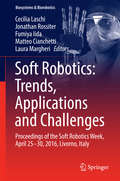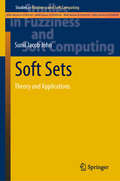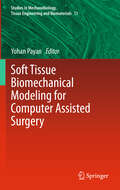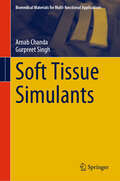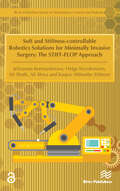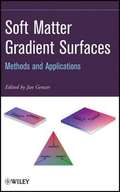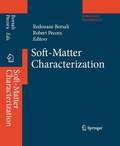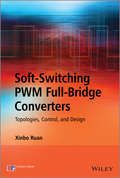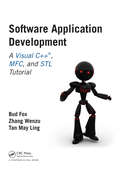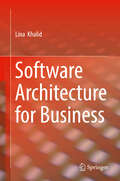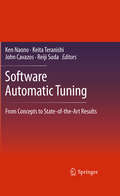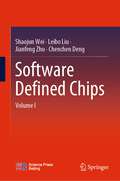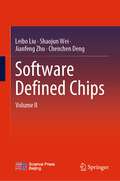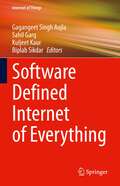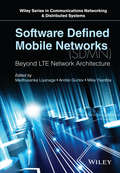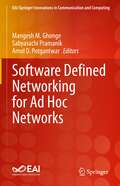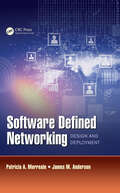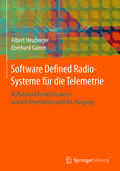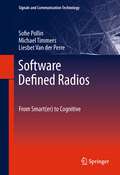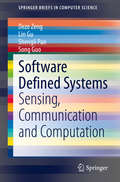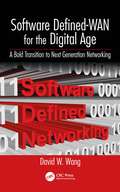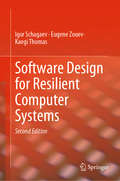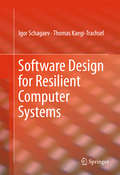- Table View
- List View
Soft Robotics: Trends, Applications and Challenges
by Cecilia Laschi Jonathan Rossiter Fumiya Iida Matteo Cianchetti Laura MargheriThis book offers a comprehensive, timely snapshot of current research, technologies and applications of soft robotics. The different chapters, written by international experts across multiple fields of soft robotics, cover innovative systems and technologies for soft robot legged locomotion, soft robot manipulation, underwater soft robotics, biomimetic soft robotic platforms, plant-inspired soft robots, flying soft robots, soft robotics in surgery, as well as methods for their modeling and control. Based on the results of the second edition of the Soft Robotics Week, held on April 25 30, 2016, in Livorno, Italy, the book reports on the major research lines and novel technologies presented and discussed during the event. "
Soft Sets: Theory and Applications (Studies in Fuzziness and Soft Computing #400)
by Sunil Jacob JohnThis book offers a self-contained guide to the theory and main applications of soft sets. It introduces readers to the basic concepts, the algebraic and topological structures, as well as hybrid structures, such as fuzzy soft sets and intuitionistic fuzzy sets. The last part of the book explores a range of interesting applications in the fields of decision-making, pattern recognition, and data science. All in all, the book provides graduate students and researchers in mathematics and various applied science fields with a comprehensive and timely reference guide to soft sets.
Soft Soil Engineering
by C.F. Lee, C.K. Lau, C.W.W. Ng, A.K. Kwong, P.L.R. Pang, J.-H. Yin & Z.Q. YueThis volume contains seven keynote lectures and over 100 technical contributions by scientists, researchers, engineers and students from more than 25 countries and regions worldwide on the subject of soft soil engineering.
Soft Target Protection: Theoretical Basis and Practical Measures (NATO Science for Peace and Security Series C: Environmental Security)
by Ladislav Hofreiter Viacheslav Berezutskyi Lucia Figuli Zuzana ZvakováThis proceedings volume includes articles presented during the Advanced Research Workshop on Soft Target Protection. The book presents important topics related to the protection of vulnerable objects and spaces, called Soft Targets. The chapters published in this book are thematically assigned to the blocks as follows: Theoretical aspect of soft target protection; Blast resistance of soft targets; Counter terrorism; Technical and technological solutions for soft target protection; Scheme and organizational measures; Blast protection and Forces for soft target protection. In this book, the reader will find a wealth of information about the theoretical background for designing protection of soft targets, as well as the specifics of protecting objects in armed conflict areas. New methods and procedures applicable to the soft target protection are described.
Soft Tissue Biomechanical Modeling for Computer Assisted Surgery
by Yohan PayanThis volume focuses on the biomechanical modeling of biological tissues in the context of Computer Assisted Surgery (CAS). More specifically, deformable soft tissues are addressed since they are the subject of the most recent developments in this field. The pioneering works on this CAS topic date from the 1980's, with applications in orthopaedics and biomechanical models of bones. More recently, however, biomechanical models of soft tissues have been proposed since most of the human body is made of soft organs that can be deformed by the surgical gesture. Such models are much more complicated to handle since the tissues can be subject to large deformations (non-linear geometrical framework) as well as complex stress/strain relationships (non-linear mechanical framework). Part 1 of the volume presents biomechanical models that have been developed in a CAS context and used during surgery. This is particularly new since most of the soft tissues models already proposed concern Computer Assisted Planning, with a pre-operative use of the models. Then, the volume addresses the two key issues raised for an intra-operative use of soft tissues models, namely (Part 2) "how to estimate the in vivo mechanical behavior of the tissues?" (i.e. what are the values of the mechanical parameters that can deliver realistic patient-specific behavior?) and (Part 3) "how to build a modeling platform that provides generic real-time (or at least interactive-time) numerical simulations?"
Soft Tissue Simulants (Biomedical Materials for Multi-functional Applications)
by Gurpreet Singh Arnab ChandaSoft tissue simulants, essential for automotive and ballistic testing, medical, and surgical training, have traditionally relied on cadavers and animal tissues. However, their biomechanical properties change with time due to dehydration after death and the biomechanics of the animal models cannot be translated and compared with the human tissues. This book compiles various synthetic tissues used in these applications, addressing their characterization and industry-wide applications. While older simulants lack biofidelity, recent advancements in biofidelic soft tissue simulants offer promising alternatives, yet technology transfer remains limited. This book fills the gap by exploring each simulant's characteristics and current trends, facilitating their adoption in clinical and academic settings. These synthetic tissues have the potential to replace live tissues in surgical training, streamlining biosafety approvals. They also benefit academic researchers by reducing costs and time in biomechanical testing. Anticipated to be the first of its kind, this comprehensive reference book will showcase recent advancements in soft tissue simulant development, serving as a cornerstone text in tissue engineering & biomedical engineering, medical simulation, biomechanics, and related fields.
Soft and Stiffness-controllable Robotics Solutions for Minimally Invasive Surgery: The STIFF-FLOP Approach (River Publishers Series In Automation, Control And Robotics Ser.)
by Kaspar Althoefer Jelizaveta Konstantinova Helge Wurdemann Ali Shafti Ali ShivaSoft and Stiffness-controllable Robotics Solutions for Minimally Invasive Surgery presents the results of a research project, funded by European Commission, STIFF-FLOP: STIFFness controllable Flexible and Learn-able manipulator for surgical Operations. In Minimally Invasive Surgery (MIS), tools go through narrow openings and manipulate soft organs that can move, deform, or change stiffness. There are limitations on modern laparoscopic and robot-assisted surgical systems due to restricted access through Trocar ports, lack of haptic feedback, and difficulties with rigid robot tools operating inside a confined space filled with organs. Also, many control algorithms suffer from stability problems in the presence of unexpected conditions. Yet biological "manipulators", like the octopus arm can manipulate objects while controlling the stiffness of selected body parts and being inherently compliant when interacting with objects. STIFF-FLOP robot is an innovative soft robotic arm that can squeeze through a standard MIS, reconfigure itself and stiffen by hydrostatic actuation to perform compliant force control tasks while facing unexpected situations. Technical topics discussed in the book include:Soft actuatorsContinuum soft manipulatorsControl, kinematics and navigation of continuum manipulatorsOptical sensors for force, torque, and curvatureHaptic feedback and human interface for surgical systemsValidation of soft stiffness controllable robots
Soft matter gradient surfaces
by Jan GenzerA comprehensive look at the latest advances in soft material gradients Tremendous progress has been made in the field of surface-bound soft material gradients in recent years, with intriguing new areas of investigation opening up and advances in bioanalytics changing the way high-throughput screening methods are used in the design and discovery of catalysts and new materials. This volume provides the first complete, up-to-date summary of the progress in this field, showing readers how to harness the powerful properties of soft matter gradients in the design and development of modern functional materials. Contributed chapters from experts in diverse fields help bridge areas of materials science, chemistry, and biomaterials, covering fabrication techniques, gradients in self-assembled monolayers, polymer gradients, dynamic gradient structures, structure and assembly, mechanical properties, sensors, biomaterial applications, protein adsorption, and organization of cells on gradient surfaces. Readers will learn how to implement the techniques described in the book in their own work, while improving efficacy and lowering research and production costs. Soft Matter Gradient Surfaces is an invaluable resource for chemists, physicists, biologists, and engineers, and anyone who would like to take advantage of these unique soft matter building blocks.
Soft-Matter Characterization
by Robert Pecora Redouane BorsaliThis 2-volume set includes extensive discussions of scattering techniques (light, neutron and X-ray) and related fluctuation and grating techniques that are at the forefront of this field. Most of the scattering techniques are Fourier space techniques. Recent advances have seen the development of powerful direct imaging methods such as atomic force microscopy and scanning probe microscopy. In addition, techniques that can be used to manipulate soft matter on the nanometer scale are also in rapid development. These include the scanning probe microscopy technique mentioned above as well as optical and magnetic tweezers.
Soft-Switching PWM Full-Bridge Converters: Topologies, Control, and Design
by Xinbo RuanSoft-switching PWM full-bridge converters have been widely used in medium-to-high power dc-dc conversions for topological simplicity, easy control and high efficiency. Early works on soft-switching PWM full-bridge converter by many researchers included various topologies and modulation strategies. However, these works were scattered, and the relationship among these topologies and modulation strategies had not been revealed. This book intends to describe systematically the soft-switching techniques for pulse-width modulation (PWM) full-bridge converters, including the topologies, control and design, and it reveals the relationship among the various topologies and PWM strategies previously proposed by other researchers. The book not only presents theoretical analysis, but also gives many detailed design examples of the converters.
Software Application Development: A Visual C++, MFC, and STL Tutorial (Chapman & Hall/CRC Computer and Information Science Series)
by Bud Fox Ph.D. Zhang Wenzu Ph.D. Tan May Ling M.Sc.Software Application Development: A Visual C++, MFC, and STL Tutorial provides a detailed account of the software development process using Visual C++, MFC, and STL. It covers everything from the design to the implementation of all software modules, resulting in a demonstration application prototype which may be used to efficiently represent mathem
Software Architecture for Business
by Lina KhalidThis book illustrates the role of software architecture and its application in business. The author describes enterprise architecture along with business architecture to show the role of software architecture in both areas. The place of software architecture in business is outlined from many perspectives in this context. The book outlines quality attributes and how managers can use software architecture to build high quality products. Topics include business software architecture, dealing with qualities, achieving quality attributes, managing business qualities, software product line, Internet of Things (IOT), and Service Oriented Business Architecture. The book is intended to benefit students, researchers, software architects, and business architects. Provides quick and easy access to all the important aspects of software architecture in business;Highlights a wide variety of concepts of software architecture in a straightforward manner, for students, practitioners, or architects;Presents different applications of software architecture in business.
Software Automatic Tuning
by Keita Teranishi Reiji Suda John Cavazos Ken NaonoAutomatic Performance Tuning is a new software paradigm which enables software to be high performance in any computing environment. Its methodologies have been developed over the past decade, and it is now rapidly growing in terms of its scope and applicability, as well as in its scientific knowledge and technological methods. Software developers and researchers in the area of scientific and technical computing, high performance database systems, optimized compilers, high performance systems software, and low-power computing will find this book to be an invaluable reference to this powerful new paradigm.
Software Defined Chips: Volume I
by Leibo Liu Shaojun Wei Jianfeng Zhu Chenchen DengThis is the first book of a two-volume book set which introduces software defined chips. In this book, it introduces the conceptual evolution of software defined chips from the development of integrated circuits and computing architectures. Technical principles, characteristics and key issues of software defined chips are systematically analyzed. The hardware architecture design methods are described involving architecture design primitives, hardware design spaces and agile design methods. From the perspective of the compilation system, the complete process from high-level language to configuration contexts is introduced in detail. This book is suitable for scientists and researchers in the areas of electrical and electronic engineering and computer science. Postgraduate students, practitioners and professionals in related areas are also potentially interested in the topic of this book.
Software Defined Chips: Volume II
by Leibo Liu Shaojun Wei Jianfeng Zhu Chenchen DengThis book is the second volume of a two-volume book set which introduces software-defined chips. In this book, the programming model of the software-defined chips is analyzed by tracing the coevolution of modern general-purpose processors and programming models. The enhancement in hardware security and reliability of the software-defined chips are described from the perspective of dynamic and partial reconfiguration. The challenges and prospective trends of software-defined chips are also discussed. Current applications in the fields of artificial intelligence, cryptography, 5G communications, etc., are presented in detail. Potential applications in the future, including post-quantum cryptography, evolutionary computing, etc., are also discussed. This book is suitable for scientists and researchers in the areas of electrical and electronic engineering and computer science. Postgraduate students, practitioners and professionals in related areas are also potentially interested in the topic of this book.
Software Defined Internet of Everything (Internet of Things)
by Gagangeet Singh Aujla Sahil Garg Kuljeet Kaur Biplab SikdarThis book provides comprehensive discussion on key topics related to the usage and deployment of software defined networks (SDN) in Internet of Everything applications like, healthcare systems, data centers, edge/fog computing, vehicular networks, intelligent transportation systems, smart grids, smart cities and more. The authors provide diverse solutions to overcome challenges of conventional network binding in various Internet of Everything applications where there is need of an adaptive, agile, and flexible network backbone. The book showcases different deployment models, algorithms and implementations related to the usage of SDN in Internet of Everything applications along with the pros and cons of the same. Even more, this book provides deep insights into the architecture of software defined networking specifically about the layered architecture and different network planes, logical interfaces, and programmable operations. The need of network virtualization and the deployment models for network function virtualization is also included with an aim towards the design of interoperable network architectures by researchers in future. Uniquely, the authors find hands on practical implementation, deployment scenarios and use cases for various software defined networking architectures in Internet of Everything applications like healthcare networks, Internet of Things, intelligent transportation systems, smart grid, underwater acoustic networks and many more. In the end, design and research challenges, open issues, and future research directions are provided in this book for a wide range of readers
Software Defined Mobile Networks (SDMN)
by Andrei Gurtov Madhusanka Liyanage Mika YlianttilaThis book describes the concept of a Software Defined Mobile Network (SDMN), which will impact the network architecture of current LTE (3GPP) networks. SDN will also open up new opportunities for traffic, resource and mobility management, as well as impose new challenges on network security. Therefore, the book addresses the main affected areas such as traffic, resource and mobility management, virtualized traffics transportation, network management, network security and techno economic concepts. Moreover, a complete introduction to SDN and SDMN concepts. Furthermore, the reader will be introduced to cutting-edge knowledge in areas such as network virtualization, as well as SDN concepts relevant to next generation mobile networks. Finally, by the end of the book the reader will be familiar with the feasibility and opportunities of SDMN concepts, and will be able to evaluate the limits of performance and scalability of these new technologies while applying them to mobile broadband networks.
Software Defined Networking for Ad Hoc Networks (EAI/Springer Innovations in Communication and Computing)
by Sabyasachi Pramanik Mangesh M. Ghonge Amol D. PotgantwarThis book offers a comprehensive overview of Software-Defined Network (SDN) based ad-hoc network technologies and exploits recent developments in this domain, with a focus on emerging technologies in SDN based ad-hoc networks. The authors offer practical and innovative applications in Network Security, Smart Cities, e-health, and Intelligent Systems. This book also addresses several key issues in SDN energy-efficient systems, the Internet of Things, Big Data, Cloud Computing and Virtualization, Machine Learning, Deep Learning, and Cryptography. The book includes different ad hoc networks such as MANETs and VANETs, along with a focus on evaluating and comparing existing SDN-related research on various parameters. The book provides students, researchers, and practicing engineers with an expert guide to the fundamental concepts, challenges, architecture, applications, and state-of-the-art developments in the field.
Software Defined Networking: Design and Deployment
by Patricia A. MorrealeSoftware Defined Networking: Design and Deployment provides a comprehensive treatment of software defined networking (SDN) suitable for new network managers and experienced network professionals. Presenting SDN in context with more familiar network services and challenges, this accessible text:Explains the importance of virtualization, particularly
Software Defined Radio-Systeme für die Telemetrie: Aufbau und Funktionsweise von der Antenne bis zum Bit-Ausgang
by Albert Heuberger Eberhard GammDieses Buch behandelt alle für ein Software Defined Radio (SDR) relevanten Systemteile: Antenne, Antennenanpassung, analoges Frontend, A/D-Umsetzung, Digital Downconversion (DDC), Interpolation, Synchronisation, Demodulation. Zunächst werden die notwendigen Grundlagen für die Darstellung von Signalen vermittelt sowie der gesamte Aufbau eines Software Defined Radios beschrieben, um anschließend die einzelnen Komponenten näher zu betrachten.Der Schwerpunkt des Buches liegt auf dem Zusammenspiel der Komponenten und Signale innerhalb des Empfängers. Zur Veranschaulichung der Signale wird das Open-Source-Programm GNU Octave verwendet.
Software Defined Radios
by Michael Timmers Sofie Pollin Liesbet Van der PerreMany and ever more mobile users wish to enjoy a variety of multimedia services, in very diverse geographical environments. The growing number of communication options within and across wireless standards is accommodating the growing volume and heterogeneity in wireless wishes. On the other hand, advancement in radio technologies opening much more flexibility, a.o. through Software Defined Radios, opens up the possibility to realize mobile devices featuring multi-mode options at low cost and interesting form factors. It is crucial to manage the new degrees of freedom opened up in radios and standards in a smart way, such that the required service is offered at satisfactory quality as efficiently as possible. Efficiency in energy consumption is clearly primordial for battery powered mobile terminals specifically, and in the context of growing ecological concerns in a broader context. Moreover, efficient usage of the spectrum is a growing prerequisite for wireless systems, and coexistence of different standards puts overall throughput at risk. The management of flexibility risks bringing about intolerable complexity and hamper the desired agility. A systematic approach, consisting of anticipative preparing for smooth operation, allows mastering this challenge. Case studies show that already today, this approach enables smart operation of radios realizing impressive efficiency gains without hampering Quality-of-Service. In the future wireless communication scenes will be able to profit form the opening of the spectrum. Even smarter and cognitive behavior will become possible and essential.
Software Defined Systems: Sensing, Communication and Computation (SpringerBriefs in Computer Science)
by Song Guo Deze Zeng Lin Gu Shengli PanThis book introduces the software defined system concept, architecture, and its enabling technologies such as software defined sensor networks (SDSN), software defined radio, cloud/fog radio access networks (C/F-RAN), software defined networking (SDN), network function virtualization (NFV), software defined storage, virtualization and docker. The authors also discuss the resource allocation and task scheduling in software defined system, mainly focusing on sensing, communication, networking and computation. Related case studies on SDSN, C/F-RAN, SDN, NFV are included in this book, and the authors discuss how these technologies cooperate with each other to enable cross resource management and task scheduling in software defined system. Novel resource allocation and task scheduling algorithms are introduced and evaluated. This book targets researchers, computer scientists and engineers who are interested in the information system softwarization technologies, resource allocation and optimization algorithm design, performance evaluation and analysis, next-generation communication and networking technologies, edge computing, cloud computing and IoT. Advanced level students studying these topics will benefit from this book as well.
Software Defined-WAN for the Digital Age: A Bold Transition to Next Generation Networking
by David W. WangSD-WAN is an advanced networking approach that creates hybrid networks to integrate broadband or other network services into the corporate WAN, not only just handling general business workloads and traffic, but also being capable of maintaining the performance and security of real-time and sensitive applications. This book posits that Software Defined (SD) WAN is the answer to questions such as what changes can be made to the networking sector? What innovations can make WAN, which plays a vital integrated part of the cloud ecosystem, more cost effective, performance robust, provisioning efficient, and operation intelligent?
Software Design for Resilient Computer Systems
by Igor Schagaev Eugene Zouev Kaegi ThomasThis book addresses the question of how system software should be designed to account for faults, and which fault tolerance features it should provide for highest reliability. With this second edition of Software Design for Resilient Computer Systems the book is thoroughly updated to contain the newest advice regarding software resilience. With additional chapters on computer system performance and system resilience, as well as online resources, the new edition is ideal for researchers and industry professionals.The authors first show how the system software interacts with the hardware to tolerate faults. They analyze and further develop the theory of fault tolerance to understand the different ways to increase the reliability of a system, with special attention on the role of system software in this process. They further develop the general algorithm of fault tolerance (GAFT) with its three main processes: hardware checking, preparation for recovery, and the recovery procedure. For each of the three processes, they analyze the requirements and properties theoretically and give possible implementation scenarios and system software support required. Based on the theoretical results, the authors derive an Oberon-based programming language with direct support of the three processes of GAFT. In the last part of this book, they introduce a simulator, using it as a proof of concept implementation of a novel fault tolerant processor architecture (ERRIC) and its newly developed runtime system feature-wise and performance-wise. Due to the wide reaching nature of the content, this book applies to a host of industries and research areas, including military, aviation, intensive health care, industrial control, and space exploration.
Software Design for Resilient Computer Systems
by Igor Schagaev Thomas Kaegi-TrachselThis book addresses the question of how system software should be designed to account for faults, and which fault tolerance features it should provide for highest reliability. The authors first show how the system software interacts with the hardware to tolerate faults. They analyze and further develop the theory of fault tolerance to understand the different ways to increase the reliability of a system, with special attention on the role of system software in this process. They further develop the general algorithm of fault tolerance (GAFT) with its three main processes: hardware checking, preparation for recovery, and the recovery procedure. For each of the three processes, they analyze the requirements and properties theoretically and give possible implementation scenarios and system software support required. Based on the theoretical results, the authors derive an Oberon-based programming language with direct support of the three processes of GAFT. In the last part of this book, they introduce a simulator, using it as a proof of concept implementation of a novel fault tolerant processor architecture (ERRIC) and its newly developed runtime system feature-wise and performance-wise. The content applies to industries such as military, aviation, intensive health care, industrial control, space exploration, etc.
